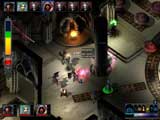 It’s a difficult
task to create and sell a competent and accurate recreation of the D&D
rulebooks. After putting together a game based on the complex set of
guidelines for combat, character creation, and equipment usage, among
other things, one then has to sell what amounts to a turn based system
to a gaming community that seems to be demanding a faster action level
and a quickened pace. The most popular games in the genre tend towards
skewed and warped versions of the D&D laws, such as Baulder’s Gate and
its “sort of, but not quite” turn based approach to combat. The Temple
of Elemental Evil, developed by Troika Games, aims for the pure blood
RPGers amongst us, adhering to a strict interpretation of the D&D 3.5
rule set, and a clean, solid graphical presentation. Accompanied by a
roughly 175 page manual, Elemental Evil does a decent job of presenting
an incredibly complex world of rules in such a way that the average
human being doesn’t get too lost in the details. Beautiful to look at,
fun to play, Elemental Evil is atmospheric and capable of dragging you
under for longer periods of time than you meant to be taken down,
despite a few flaws in design. While difficult, and lacking any
resemblance to mercy for the poorly skilled, a good night in the
dungeons of this game will send chills up your spine. It’s a difficult
task to create and sell a competent and accurate recreation of the D&D
rulebooks. After putting together a game based on the complex set of
guidelines for combat, character creation, and equipment usage, among
other things, one then has to sell what amounts to a turn based system
to a gaming community that seems to be demanding a faster action level
and a quickened pace. The most popular games in the genre tend towards
skewed and warped versions of the D&D laws, such as Baulder’s Gate and
its “sort of, but not quite” turn based approach to combat. The Temple
of Elemental Evil, developed by Troika Games, aims for the pure blood
RPGers amongst us, adhering to a strict interpretation of the D&D 3.5
rule set, and a clean, solid graphical presentation. Accompanied by a
roughly 175 page manual, Elemental Evil does a decent job of presenting
an incredibly complex world of rules in such a way that the average
human being doesn’t get too lost in the details. Beautiful to look at,
fun to play, Elemental Evil is atmospheric and capable of dragging you
under for longer periods of time than you meant to be taken down,
despite a few flaws in design. While difficult, and lacking any
resemblance to mercy for the poorly skilled, a good night in the
dungeons of this game will send chills up your spine.
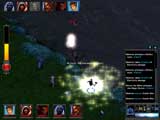 In most elements
of the gameplay, Elemental Evil covers up the complexity of its roots
rather well. Arrows fly by their targets with a hit or miss, battleaxes
fall without a single die roll being evident. This doesn’t hold true for
character creation, and rightfully so. In a game such as this, creating
and developing your character is half the fun. Killing the monster isn’t
fun, getting that really big and expensive weapon so you can play with
the monster like a cat does a mouse, then and obliterating the monster –
that’s fun. In order to customize your character, you have to go through
the options of choosing his alignment, his skills, his class, and race.
Unfortunately, that means that if you’re unfamiliar with the D&D
universe, the first half hour of so of the game, before any story takes
place, before any fighting, you’ll enjoy it hunched over the starting
pages of the manual, reading about every option on the list. So the slow
part, the tedious part, the part that will have the average, non-RPG
gamer out there on the fence giving up and walking away, hits you right
up front. Once you get passed that, however, Elemental Evil lays out a
stunning graphic adventure for you. In most elements
of the gameplay, Elemental Evil covers up the complexity of its roots
rather well. Arrows fly by their targets with a hit or miss, battleaxes
fall without a single die roll being evident. This doesn’t hold true for
character creation, and rightfully so. In a game such as this, creating
and developing your character is half the fun. Killing the monster isn’t
fun, getting that really big and expensive weapon so you can play with
the monster like a cat does a mouse, then and obliterating the monster –
that’s fun. In order to customize your character, you have to go through
the options of choosing his alignment, his skills, his class, and race.
Unfortunately, that means that if you’re unfamiliar with the D&D
universe, the first half hour of so of the game, before any story takes
place, before any fighting, you’ll enjoy it hunched over the starting
pages of the manual, reading about every option on the list. So the slow
part, the tedious part, the part that will have the average, non-RPG
gamer out there on the fence giving up and walking away, hits you right
up front. Once you get passed that, however, Elemental Evil lays out a
stunning graphic adventure for you.
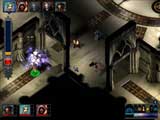 Based on the same
engine that drives Baulder’s Gate and Icewind Dale, Elemental Evil is
graphically beautiful, with excellent environmental and character
detail. As you walk through the forest, the trees rustle in the wind,
and with that wind comes perfect environmental sounds. When you’re in
the dungeons and the light plays out before you, slowly revealing more
and more of your destination and any creature that may linger there, the
atmosphere is wonderful. Simply wonderful. Based on the same
engine that drives Baulder’s Gate and Icewind Dale, Elemental Evil is
graphically beautiful, with excellent environmental and character
detail. As you walk through the forest, the trees rustle in the wind,
and with that wind comes perfect environmental sounds. When you’re in
the dungeons and the light plays out before you, slowly revealing more
and more of your destination and any creature that may linger there, the
atmosphere is wonderful. Simply wonderful.
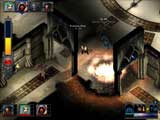 It’s a shame,
then, that certain design elements did not receive such excellent
attention to detail. There are small flaws, really, elements that
interfere with the emersion of the game. For example, when you are
fighting in the forest and an enemy falls beneath a tree, good luck
finding his body for looting. Where moments before you were happily
battling for life and loot, suddenly you’re left clicking randomly in
the foliage in hopes one of your characters will accidentally stumble
over the enemy’s corpse (which, we presume, fell under a pile of leaves
on dying and is thus difficult to see). This sort of thing also
represents a problem in dungeons when near walls or fighting in close
combat. Your minions, and their minions, are both equally hard to
distinguish when in tight areas, and it’s relatively easy to
accidentally end up shooting your own teammate with a crossbow bolt. It’s a shame,
then, that certain design elements did not receive such excellent
attention to detail. There are small flaws, really, elements that
interfere with the emersion of the game. For example, when you are
fighting in the forest and an enemy falls beneath a tree, good luck
finding his body for looting. Where moments before you were happily
battling for life and loot, suddenly you’re left clicking randomly in
the foliage in hopes one of your characters will accidentally stumble
over the enemy’s corpse (which, we presume, fell under a pile of leaves
on dying and is thus difficult to see). This sort of thing also
represents a problem in dungeons when near walls or fighting in close
combat. Your minions, and their minions, are both equally hard to
distinguish when in tight areas, and it’s relatively easy to
accidentally end up shooting your own teammate with a crossbow bolt.
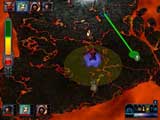 Other problems
range from the significant to the minor. It would have been nice had the
inventory screen listed information on how much a character could carry
before becoming encumbered, automatically calculating such details about
how badly injured the character may be. As it is, all that’s given is
the total weight the individual is carrying, and then leaves it up to
you to look up the character’s strength, and use the manual to determine
his encumbrance point. If he’s hurt and can’t carry as much, it simply
informs you that your character is encumbered, but neglects to mention
how much weight he has to shed in order to be up and trotting with
normal agility again. Other problems
range from the significant to the minor. It would have been nice had the
inventory screen listed information on how much a character could carry
before becoming encumbered, automatically calculating such details about
how badly injured the character may be. As it is, all that’s given is
the total weight the individual is carrying, and then leaves it up to
you to look up the character’s strength, and use the manual to determine
his encumbrance point. If he’s hurt and can’t carry as much, it simply
informs you that your character is encumbered, but neglects to mention
how much weight he has to shed in order to be up and trotting with
normal agility again.
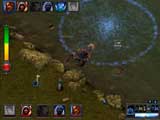 Another minor
problem with design has to do with dialog. Say you enter a room, and you
click on a non-player character to start up a conversation for the first
time. Your muscle man, a big brute with the IQ of a crow – meaning he
can yield tools but conveys emotional states mainly with grunts – takes
the initiative and says something suave like, “Me Joe.” Realizing your
mistake, you click your quickest available option to get out of the
conversation – which happens to be, “Me leave,” – and reinstate dialogue
with your wizard. Another minor
problem with design has to do with dialog. Say you enter a room, and you
click on a non-player character to start up a conversation for the first
time. Your muscle man, a big brute with the IQ of a crow – meaning he
can yield tools but conveys emotional states mainly with grunts – takes
the initiative and says something suave like, “Me Joe.” Realizing your
mistake, you click your quickest available option to get out of the
conversation – which happens to be, “Me leave,” – and reinstate dialogue
with your wizard.
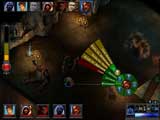 The damage,
though, is already done. This NPC, who you’ve exchanged no more
information with than the name of your rather bulky friend, starts off
asking all sorts of personal and knowledgeable questions, as if
somewhere between you’re saying hello and you’re saying goodbye, another
part of you was actually engaged in some sort of bonding experience. The
game assumes that once you’ve chatted with a NPC, no matter how briefly,
that you’ve already stripped him of all the relevant information you
need, and changes the dialog options. So the first time you click, no
matter how little talking you actually do, a question you can ask might
be, “How do you keep this inn up on your own? Do you have a family?”
Re-clicking will have your character saying things like, “Fred, I think
I may have figured out a way to help your daughter save the farm and
marry that blacksmith that she loves over yonder, who’s having the spat
with the hay guy that you told me about last time we chatted.” No matter
how large the leaps in conversation, the characters never seem to get
lost, but it leaves their human masters staring at the screen wondering
just what exactly is going on. The damage,
though, is already done. This NPC, who you’ve exchanged no more
information with than the name of your rather bulky friend, starts off
asking all sorts of personal and knowledgeable questions, as if
somewhere between you’re saying hello and you’re saying goodbye, another
part of you was actually engaged in some sort of bonding experience. The
game assumes that once you’ve chatted with a NPC, no matter how briefly,
that you’ve already stripped him of all the relevant information you
need, and changes the dialog options. So the first time you click, no
matter how little talking you actually do, a question you can ask might
be, “How do you keep this inn up on your own? Do you have a family?”
Re-clicking will have your character saying things like, “Fred, I think
I may have figured out a way to help your daughter save the farm and
marry that blacksmith that she loves over yonder, who’s having the spat
with the hay guy that you told me about last time we chatted.” No matter
how large the leaps in conversation, the characters never seem to get
lost, but it leaves their human masters staring at the screen wondering
just what exactly is going on.
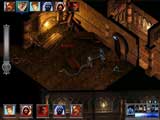 The more
significant errors all tend to fall in the category of bugs. From the
occasional program crash, to the fact that if you save your game during
an enemy’s combat turn you can never re-load it successfully, Elemental
Evil has some significant problems. In some respects, Elemental Evil
feels like an unfinished game of the type that happens when a
development team is pushed too hard to produce too early. Most of these
are addressed in a patch available from the Elemental Evil website,
released on November 19th. I highly recommend it. In fact, reading over
the list of bugs fixed, it’s an absolute necessity. One error even
allowed you tell an NPC that you had completed an important quest to
receive credit for it, and to move on the game, whether you had done the
job or not. But the option was there in the dialogue, and so click on
it, and boom. Done. The patch is simply a must. The more
significant errors all tend to fall in the category of bugs. From the
occasional program crash, to the fact that if you save your game during
an enemy’s combat turn you can never re-load it successfully, Elemental
Evil has some significant problems. In some respects, Elemental Evil
feels like an unfinished game of the type that happens when a
development team is pushed too hard to produce too early. Most of these
are addressed in a patch available from the Elemental Evil website,
released on November 19th. I highly recommend it. In fact, reading over
the list of bugs fixed, it’s an absolute necessity. One error even
allowed you tell an NPC that you had completed an important quest to
receive credit for it, and to move on the game, whether you had done the
job or not. But the option was there in the dialogue, and so click on
it, and boom. Done. The patch is simply a must.
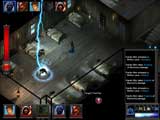 Not that The
Temple of Elemental Evil is bad. In fact, such hang-ups, crashes, and
difficulties are all the more frustrating because Elemental Evil is a
game that wants to be played. From the opening animations to the
tutorial, to the start of your adventure in the underground dungeons of
the temple, TOEE begs to be played. When the music starts to play, you
know you’re in for a treat. Not that The
Temple of Elemental Evil is bad. In fact, such hang-ups, crashes, and
difficulties are all the more frustrating because Elemental Evil is a
game that wants to be played. From the opening animations to the
tutorial, to the start of your adventure in the underground dungeons of
the temple, TOEE begs to be played. When the music starts to play, you
know you’re in for a treat.
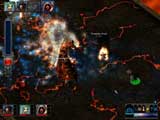 So while novice
D&D player can expect a tough time getting going, with plenty of death
all around, experienced players will find a accurate and detailed
recreation of the Dungeons and Dragons experience. With a heavy focus on
combat and dungeon exploring, over, say, NPC interaction, TOEE is more
for those looking to beef up with the bigger axe to fall the bigger
giant more than to solve the local villages problems with their water
supply, but is nonetheless a worthy and entertaining foray into a world
that could easily have been bogged down by details. Remarkably
accessible for the average player interested in D&D games, Troika Games
has done a good job in producing a solid and entertaining experience. So while novice
D&D player can expect a tough time getting going, with plenty of death
all around, experienced players will find a accurate and detailed
recreation of the Dungeons and Dragons experience. With a heavy focus on
combat and dungeon exploring, over, say, NPC interaction, TOEE is more
for those looking to beef up with the bigger axe to fall the bigger
giant more than to solve the local villages problems with their water
supply, but is nonetheless a worthy and entertaining foray into a world
that could easily have been bogged down by details. Remarkably
accessible for the average player interested in D&D games, Troika Games
has done a good job in producing a solid and entertaining experience.
Eric Stanton (11/21/2003) |
